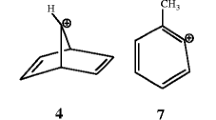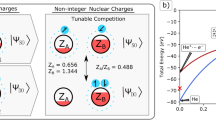Abstract
If the potential V describing the interaction between an excess electron and a ground-state neutral or anionic parent is sufficiently attractive at short range, electron-attached states having positive electron affinities (EAs) can arise. Even if the potential is not attractive enough to produce a bound state, metastable electron-attached states may still occur and have lifetimes long enough to give rise to experimentally detectable signatures. Low-energy metastable states arise when the attractive components of V combine with a longer-range repulsive contribution to produce a barrier behind which the excess electron can be temporarily trapped. These repulsive contributions arise from either the centrifugal potential in the excess electron’s angular kinetic energy or long-range Coulomb repulsion in the case of an anionic parent. When there is no barrier, this kind of low-energy metastable state does not arise, but improper theoretical calculations can lead to erroneous predictions of their existence. Conventional electronic structure methods with, at most, minor modifications are described for properly characterizing metastable states and for avoiding incorrectly predicting the existence of metastable states with negative EAs where no barrier is present.











Similar content being viewed by others
References
Love DE, Jordan KD (1995) Electron impact excitation of the singlet and triplet B1u π π* states of ethylene near threshold. Chem Phys Lett 235:479–483
Callaway J, LaBahn RW, Pu RT, Duxler WM (1968) Extended polarization potential: applications to atomic scattering. Phys Rev 68:12–21
Kunc JA (1999) Low-energy electron–atom scattering in a field of model potentials. J Phys B 32:607–619
LaBahn RW, Callaway J (1966) Elastic scattering of low-energy electrons from atomic helium. Phys Rev 147:28–40
Voora VK, Ding J, Sommerfeld T, Jordan KD (2012) A self-consistent polarization potential model for describing excess electrons interacting with water clusters. J Phys Chem B 117:4365–4370
Schulz GJ (1973) Resonances in electron impact on diatomic molecules. Rev Mod Phys 45:423–486
Ehrhardt H, Langhans L, Linder F, Taylor HS (1968) Resonance scattering of slow electrons from H2 and CO angular distributions. Phys Rev 173:222–230
Sanche L, Schulz GJ (1973) Electron transmission spectroscopy: resonances in triatomic molecules and hydrocarbons. J Chem Phys 58:479–493
Rescigno TN, Byrum DA, Isaacs WA, McCurdy CW (1999) Theoretical studies of low-energy electron-CO2 scattering: total, elastic, and differential cross sections. Phys Rev A 60:2186–2193
Savin A (1996) Recent developments and applications of modern density functional theory. Elsevier, Amsterdam, p 327
Taylor HS (1970) Models, interpretations, and calculations concerning resonant electron scattering processes in atoms and molecules. Adv Chem Phys 18:91–147
Hazi AU, Taylor HS (1970) Stabilization method of calculating resonance energies: model problem. Phys Rev A 1:1109–1120
Moiseyev N, Certain PR, Weinhold F (1978) Complex-coordinate studies of helium autoionizing resonances. Inter J Quantum Chem 14:727–736
Schirmer J, Cederbaum LS, Walter O (1983) New approach to the one-particle Green’s function for finite Fermi systems. Phys Rev A 28:1237–1259
Nooijen M, Bartlett RJ (1995) Equation of motion coupled cluster method for electron attachment. J Chem Phys 102:3629–3647
Simons J (2005) Equations of motion (EOM) methods for computing electron affinities and ionization potentials. In: Dykstra CE, Frenking G, Kim KS, Scuseria G (eds) Theory and applications of computational chemistry: the first 40 years, a volume of technical and historical perspectives, chap 17. Elsevier, pp 443–461
Jordan KD (1979) The early history of the study of electrons binding to dipoles is overviewed. Negat Ion States Polar Mol Acc Chem Res 12:36–42
Wang F, Jordan KD (2003) Theory of dipole-bound anions. Ann Rev Phys Chem 54:367–396
Garrett WR (1970) Critical binding of an electron to a non-stationary electric dipole. Chem Phys Lett 5:393–397
Garrett WR (1971) Critical binding of an electron to a rotationally excited dipolar system. Phys Rev A 3:961–972
Crawford OH (1968) Electron collision frequencies in water vapor. Chem Phys Lett 2:461–463
Wang L-S, Wang X-B (2000) Probing free multiply charged anions using photodetachment photoelectron spectroscopy. J Phys Chem A 104:1978–1990
Burrow PD, Michejda JA, Comer J (1976) Low-energy electron scattering from Mg, Zn, Cd and Hg: shape resonances and electron affinities. J Phys B Atom Mol Phys 9:3225–3236
Petrunin VV, Andersen HH, Balling P, Andersen T (1996) Structural properties of the negative calcium ion: binding energies and fine-structure splitting. Phys Rev Lett 76:744–747
Johnston AR, Burrow PD (1979) Temporary negative-ion formation in calcium vapor. Bull Am Phys Soc 24:1189
Romanyuk NI, Shpenik OB, Zapesochnyi IP (1980) Cross sections and characteristics of electron scattering by calcium, strontium, and barium atoms. JETP Lett 32:452–455
Koopmans T (1934) Über die Zuordnung von Wellenfunktionen und Eigenwerten zu den Einzelnen Elektronen Eines Atoms. Physica 1:104–113
Krishnan R, Binkley JS, Seeger R, Pople JA (1980) Self-consistent molecular orbital methods. XX. A basis set for correlated wave functions. J Chem Phys 72:650–654
Simons J (1981) Resonance state lifetimes from stabilization graphs. J Chem Phys 75:2465–2467
Chao JS-Y, Falcetta MF, Jordan KD (1990) Application of the stabilization method to the N2 −(2Πg) and Mg−(2P) temporary anion states. J Chem Phys 93:1125–1135
Nestmann B, Peyerimhoff SD (1985) Calculation of the discrete component of resonance states in negative ions by variation of nuclear charges. J Phys B 18:615–626
Whitehead A, Barrios R, Simons J (2002) Stabilization calculation of the energy and lifetime of metastable SO4 2−. J Chem Phys 116:2848–2851
Herrick DR, Stillinger FH (1975) Energy and lifetime of 02− from analytic continuation of isoelectronic bound states. J Chem Phys 62:436–4365
Sergeev A, Kais S (2001) Resonance states of atomic anions. Inter J Quantum Chem 82:255–261
Wang X-B, Nicholas JB, Wang L-S (2000) Electronic instability of isolated SO4 2− and its solvation stabilization. J Chem Phys 113:10837
Jordan KD, Burrow PD (1987) Temporary anion states of polyatomic hydrocarbons. Chem Rev 87:557–588
Acknowledgments
K.D.J. acknowledges the support of Grant CHE1111235 from the National Science Foundation.
Author information
Authors and Affiliations
Corresponding author
Additional information
Dedicated to Professor Thom Dunning and published as part of the special collection of articles celebrating his career upon his retirement.
Rights and permissions
About this article
Cite this article
Jordan, K.D., Voora, V.K. & Simons, J. Negative electron affinities from conventional electronic structure methods. Theor Chem Acc 133, 1445 (2014). https://doi.org/10.1007/s00214-014-1445-1
Received:
Accepted:
Published:
DOI: https://doi.org/10.1007/s00214-014-1445-1




